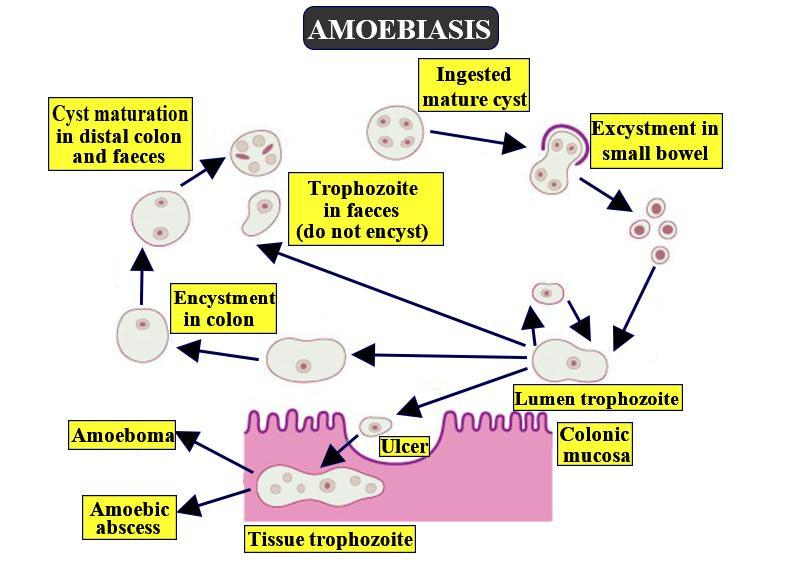
Name the pathogen that causes amoebiasis in humans. Give the symptoms and the mode of transmission of the disease.
Answer
478.2k+ views
Hint: Amoebiasis or amoebic dysentery is a parasitic infection. The disease is named after the causative organism and the parasite predominantly infects humans and other primates. The name of the species that most commonly causes the infection translates to the disintegration and dissolution of organic tissues.
Complete Step by Step Answer:
The amoebae of the Entamoeba group causes the infection amoebiasis, but is mostly caused by the infection of Entamoeba histolytica. It is estimated to infect about 35- 50 million people worldwide. It primarily affects humans and other primates. Though other mammals such as cats and dogs may be infected transiently, they do not significantly contribute to transmission.

Symptoms occur in a few days to a few weeks after the infection which is usually about two to four weeks. Symptoms range from mild diarrhoea to dysentery with blood and intense abdominal pains. Some extra- intestinal complications may also be seen as a result of invasive infections such as colitis, liver, lung, or brain abscess.
Amoebiasis is generally transmitted through the faecal- oral route, but it may also be transmitted through contact with dirty hands or objects. The infection is spread through the ingestion of the cyst form of the parasite that is a semi- dormant and hard structure that is found in the faeces.
Note:
- In 90% of the cases, the infection is asymptomatic.
- Any non- encysted amoebae or trophozoites if present, die soon after leaving the body. In some cases, they may be present in the stool and may rarely be a source of new infections.
- Since the infection is spread through contaminated food and water, it is often endemic in regions with limited modern sanitation systems.
- Amoebic dysentery is a kind of traveller’s diarrhoea and unlike most traveller's diarrhoea that is bacterial or viral in origin, it is caused by a protozoan parasite.
Complete Step by Step Answer:
The amoebae of the Entamoeba group causes the infection amoebiasis, but is mostly caused by the infection of Entamoeba histolytica. It is estimated to infect about 35- 50 million people worldwide. It primarily affects humans and other primates. Though other mammals such as cats and dogs may be infected transiently, they do not significantly contribute to transmission.

Symptoms occur in a few days to a few weeks after the infection which is usually about two to four weeks. Symptoms range from mild diarrhoea to dysentery with blood and intense abdominal pains. Some extra- intestinal complications may also be seen as a result of invasive infections such as colitis, liver, lung, or brain abscess.
Amoebiasis is generally transmitted through the faecal- oral route, but it may also be transmitted through contact with dirty hands or objects. The infection is spread through the ingestion of the cyst form of the parasite that is a semi- dormant and hard structure that is found in the faeces.
Note:
- In 90% of the cases, the infection is asymptomatic.
- Any non- encysted amoebae or trophozoites if present, die soon after leaving the body. In some cases, they may be present in the stool and may rarely be a source of new infections.
- Since the infection is spread through contaminated food and water, it is often endemic in regions with limited modern sanitation systems.
- Amoebic dysentery is a kind of traveller’s diarrhoea and unlike most traveller's diarrhoea that is bacterial or viral in origin, it is caused by a protozoan parasite.
Recently Updated Pages
Master Class 12 Economics: Engaging Questions & Answers for Success

Master Class 12 Maths: Engaging Questions & Answers for Success

Master Class 9 General Knowledge: Engaging Questions & Answers for Success

Master Class 9 English: Engaging Questions & Answers for Success

Master Class 9 Science: Engaging Questions & Answers for Success

Master Class 9 Social Science: Engaging Questions & Answers for Success

Trending doubts
Who is Mukesh What is his dream Why does it look like class 12 english CBSE

Who was RajKumar Shukla Why did he come to Lucknow class 12 english CBSE

The word Maasai is derived from the word Maa Maasai class 12 social science CBSE

What is the Full Form of PVC, PET, HDPE, LDPE, PP and PS ?

Which country did Danny Casey play for class 12 english CBSE

Differentiate between insitu conservation and exsitu class 12 biology CBSE




